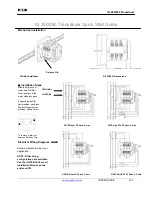
Transmit (XMT) LED
This green LED flashes when
the transceiver puts data onto the network. The LED
flash is pulse-stretched for viewing effect. The XMT
LED stays off if the device is active, but not transmitting
data onto the network.
Receive (RCV) LED
This yellow LED flashes when
the FOT-F receives data from the network. If the trans-
ceiver is attached to a device such as a repeater, RCV
flashes when data passes through the FOT-F. The
LED flash is pulse-stretched for viewing effect.
Collision Present (CLN) LED
This red LED flashes
when the transceiver detects a collision condition or a
jabber packet on the network. The flash frequency may
increase as network activity increases since more col-
lisions are likely to occur. The LED flash is pulse-
stretched for viewing effect.
Media Link Good (LNK) LED
When lit, this green
LED indicates that a link exists between the transceiver
and the device at the other end of the fiber pair seg-
ment. LNK remains lit as long as the link is main-
tained. To ensure that a link is maintained, the trans-
ceiver generates a 1 MHz idle signal when it is not
transmitting data.
Getting Help
If you have questions, or need additional help, contact
Cabletron Systems Technical Support as follows:
By phone:
Monday through Friday,
8 am to 8 pm EST at
(603) 332-9400
By CompuServe:
GO CTRON from any ! prompt
By Internet mail:
LANVIEW
is a registered trademark of Cabletron
Systems, Inc.
FOT-F14
,
FOT-F24
, and
FOT-F25
are trademarks of
Cabletron Systems, Inc.
CompuServe
is a registered trademark of
CompuServe, Inc.
Ethernet
is a trademark of Xerox Corp.
FCC NOTICE
This device complies with Part 15 of the FCC rules.
Operation is subject to the following two conditions: (1)
this device may not cause harmful interference, and
(2) this device must accept any interference received,
including interference that may cause undesired
operation.
NOTE: This equipment has been tested and found to
comply with the limits for a Class A digital device,
pursuant to Part 15 of the FCC rules. These limits are
designed to provide reasonable protection against
harmful interference when the equipment is operated
in a commercial environment. This equipment uses,
generates, and can radiate radio frequency energy
and if not installed in accordance with the operator’s
manual, may cause harmful interference to radio
communications. Operation of this equipment in a
residential area is likely to cause interference in which
c a s e t h e u s e r w i l l b e r e q u i r e d t o c o r r e c t t h e
interference at his own expense.
WARNING:
Changes or modifications made to this
device which are not expressly approved by the party
responsible for compliance could void the user’s
authority to operate the equipment.
DOC NOTICE
This digital apparatus does not exceed the Class A lim-
its for radio noise emissions from digital apparatus set
out in the Radio Interference Regulations of the Cana-
dian Department of Communications.
NOTICE
Cabletron Systems reserves the right to make changes
in specifications and other information contained in this
document without prior notice. The reader should in all
cases consult Cabletron Systems to determine wheth-
er any such changes have been made. The hardware,
firmware, or software described in this manual is sub-
ject to change without notice.
IN NO EVENT SHALL CABLETRON SYSTEMS BE
L I A B L E F O R A N Y I N C I D E N TA L , I N D I R E C T,
S P E C I A L , O R C O N S E QU E N T I A L DA M AG E S
WHATSOEVER (INCLUDING, BUT NOT LIMITED TO,
LOST PROFITS) ARISING OUT OF OR RELATED TO
THIS MANUAL OR THE INFORMATION CONTAINED
IN IT, EVEN IF CABLETRON SYSTEMS HAS BEEN
ADVISED OF, KNOWN OR SHOULD HAVE KNOWN,
THE POSSIBILITY OF SUCH DAMAGES.
Part Number 9030652-01
© Copyright August 1994 by
Cabletron Systems, Inc.
P.O. Box 5005, Rochester, NH 03866-5005
All Rights Reserved
Printed in the United States of America
FOT-F14 FOT-F24 FOT-F25
802.3 10BASE-FL
Transceiver User’s Guide
The
FOT-F14™
,
FOT-F24™
, and
FOT-F25™
fiber op-
tic transceivers are each designed to link two Ether-
net™ devices through fiber optic cable. The three
transceiver types are identical except for the type of ca-
ble connectors:
FOT-F14: SMA Connector Ports and 10" AUI Cable
FOT-F24: ST Connector Ports and 10" AUI Cable
FOT-F25: ST Connector Ports and 90
°
AUI Port
The specifications and instructions in this guide apply
to all three fiber optic transceiver models, which are
collectively called the FOT-F.
Requirements
The FOT-F complies with IEEE 802.3 10BASE-FL
specifications. You can use the FOT-F transceivers
with Version 1, Version 2, and/or IEEE 802.3 equip-
ment. For best network performance, be sure to ob-
serve the following network guidelines.
Distance and Cable Type
The FOT-F supports
50/125
µ
m, 62.5/125
µ
m, and 100/140
µ
m fiber optic
cable. Link length depends on cable type and the sys-
tem fiber optic budget. IEEE 802.3 10BASE-FL specifi-
cations allow a maximum link length of 1 km. However,
if the system budgets are met, then a 2 km link length
is possible.
Link Attenuation
At an 850 nm wave length, link seg-
ment attenuation can be no more than:
• 13.0 db for 50/125 fiber cable
• 16.0 db for 62.5/125 fiber cable
• 19.0 db for 100/140 fiber cable
AUI Cable
The AUI port connects the transceiver to an
Ethernet device. The cable you connect can be up to
50 meters long and must comply with IEEE 802.3 or
with Ethernet Version 1 or 2 specifications.




















